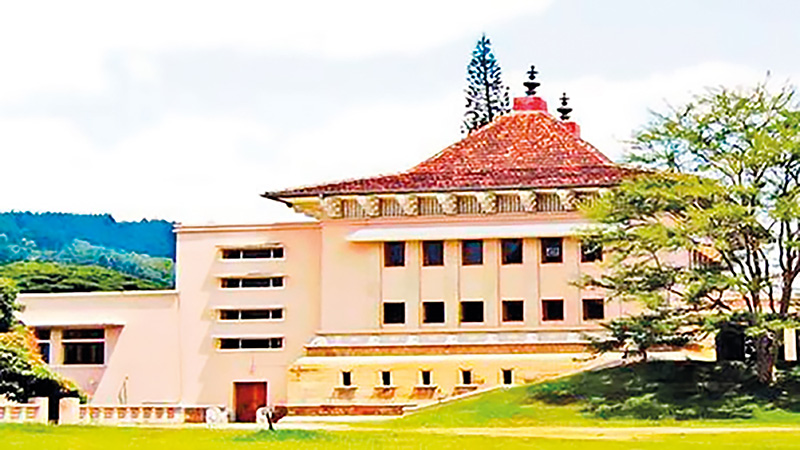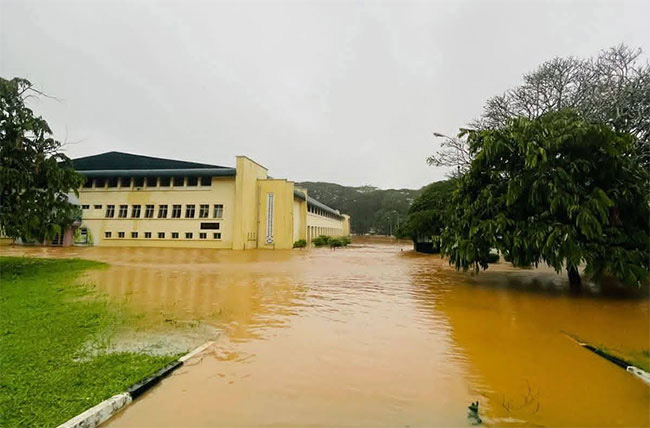Features
Proposed wage-increase for tea plantation workers:

How it affects the small holders
by Dr Janaka Ratnasiri
The Cabinet of Ministers, at its meeting held on 26.01.2021, has decided to amend the Wages Board Regulations (WBR) by making it mandatory for tea plantation workers be paid a minimum of Rs. 1,000.00 a day. This is a follow up to the proposal made by the Finance Minister in his Budget Speech that “I also propose to increase the daily wage of plantation workers to Rs. 1,000 from January 2021”.
DEMAND BY THE PLANTATION WORKERS FOR A WAGE INCREASE
Since about 2016, tea plantation trade unions have been demanding that a daily wage of Rs. 1,000 be paid to their workers. However, the regional plantation companies (RPC) were resisting their demands, despite intervention by ministers from time to time. In order to ensure votes from the plantation workers, prior to the election, a pledge was given by those who are in office now, that the plantation worker salaries will be increased. The proposal in the budget speech, as well as the recent amendment to the WBR, were outcomes of this pledge.
Tea is grown in Sri Lanka by two groups, the large plantations managed by the Regional Plantation Companies including other public sector institutes, and the small holders of extent below 10 Acres each. According to the 2015 Annual Report of the Tea Small Holdings Development Authority (TSHDA), the small holders produced about 240 million kg of made tea in 2015, while the large estates produced 87 million kg, which are 73% and 27% of the total production, respectively. According to the TSHDA Report, the number of small holdings below 0.5 ha extent comprise 88% which are mostly managed by family members. The rest up to 10 Acres or 4 ha employ paid workers and they are subject to WBR.
The demand for wage increase came from plantation company workers where salaries paid to workers are decided by the collective agreement between the RPCs and worker trade unions negotiated once in two years. During the last agreement, RPCs have offered an increase of the basic to Rs. 600 a day and increases in some allowances making the total daily wage to Rs. 940.00 subject to good attendance (Daily FT, 26.10.2018). But this was not acceptable to the worker unions.
The RPCs have called for a new wage structure focusing on a revenue share model that could have sweeping productivity-focused reforms in the entire industry. An option favoured by the trade unions is the out-grower model where the workers are allocated small plots of land to grow their own tea to sell to the factories (Daily FT of 19.02.2019). In view of this deadlock, the COM decided to incorporate the LKR 1000 as minimum daily wage payable to tea industry workers which is applicable to both estate and small holding workers.
Despite this Cabinet decision, tea plantation workers across the up-country have launched a token strike demanding immediate payment of the agreed pay hike to them, as some RPCs were hesitant to implement the Government decision. With an annual export earning of LKR 240 billion in 2019, a single day production outage means a loss of over LKR 600 million a day to the country.
PRESENT EARNINGS OF PLANTATION WORKERS
Currently, WBR specifies that the tea plantation workers should be paid a minimum of LKR 680.00 a day, subject to satisfactory attendance during the month. In addition, they are paid EPF at 12% of basic salary of Rs. 545.00 and 3% for ETF, making the total wages Rs. 761.75. It should be remembered that plantation workers generally work only for about 6 hours from 0730 h to 1330 h including 30 min for a tea break. They have to stop plucking early so that the day’s collection could be handed over after weighing to the lorry which comes around 1400 h. A plucker works for a maximum of 22 days a month because it takes about a week for a new shoot to develop to be plucked again.
But, on an average, a plucker may work only for about 16-18 days and after deducting his own EFP contribution, may have a take-home pay of about Rs. 12,200 – 13,700 a month. If they pluck above the minimum quota, they may be paid extra at rates varying from employer to employer from Rs./kg 25 to 30, they can earn extra, provided the bushes in the worker’s lot have shoots. Both during dry months (no moisture) and wet months (no radiation), the shoot growth declines and the average yield drops and much extra revenue cannot be expected during these months.
Being daily paid workers, they are not entitled for any paid casual or sick leave unlike monthly paid workers elsewhere. No work means no pay. Unlike other workers in the mercantile sector, tea workers are not entitled for mercantile holidays, neither they have any annual leave. Whereas, in the case of all public sector and mercantile sector workers, the EPF contribution is computed based on the total salary received, in the case of plantation workers, it is computed based on the basic salary only.
The writer believes that this is a violation of the EPF Act. Though workers employed by RPCs may get free housing and free medical facilities, such benefits are not available to the large number of workers employed in the small-holder sector. Hence, there is a need to increase the wages paid to these workers to compensate for the loss of all these benefits.
In announcing the proposed wage hike for plantation workers, both the Government and the RPCs are deceiving them by adding the employers’ contribution to EPF and ETF as a part of the daily wage of Rs. 1,000. This is not done anywhere else either in the public or in the mercantile sector. When they announce a salary scale, only the basic salary along with allowances are shown, but not the EPF and ETF contributions. The workers themselves may not have understood the difference, but their unions should have seen the unfairness of this computation.
IMPACT OF THE WAGE INCREASE ON THE SMALL HOLDER SECTOR
Small holders get paid for the green leaf supplied to factories at a rate determined by the auction price paid to factories the previous month. Currently, the rate is about Rs. 90 per kilo after deducting for transport and sack weight. In the writer’s experience, a small holding of four acres with an average yield of 1,500 kg of green leaf a month, brings a monthly revenue of Rs. 135,000. The salary bill for four pluckers and a Kankanama will come to an average of Rs. 80,000 a month. This comprises Rs. 30,000 paid to the Kankanama and LKR 12,500 paid to each plucker on an average, including their EPF and ETF contributions. This works out to Rs. 781 a month per plucker, a little over Rs. 762, the minimum specified in the WBR.
The cost of weeding which is done manually, maintenance of drains and retaining walls on an average comes to about Rs. 25,000 a month. The cost of fertilizers and dolomite and their application costs another Rs. 6,000 a month on an average. In addition, there are other costs of infilling, pruning and replanting of unproductive sections which works out to about Rs. 14,000 a month. This leaves only Rs. 10,000 a month as income from the small holding, which is even less than what a worker earnes a month.
Once the WBR is amended to increase the daily wages to Rs. 1000, the Labour Officers will spare no time in visiting the small holdings and insisting the new wages be implemented. If this is done, it will be an added financial burden of Rs. 15,360 a month. This exceeds the amount left in hand after attending to its management properly. Since the small holdings depend entirely on the money paid by the factories, the obvious solution is to increase this amount at least by Rs. 20 a kilo which leaves behind a decent balance in hand. It is obvious that the COM was not concerned about the small holdings when it decided to amend the WBR, but had only the concerns about the RPC workers in mind.
INCREASING THE PAYMENT TO SMALL HOLDINGS BY FACTORIES
Tea samples offered at the auctions are purchased mostly by exporters for supplying to overseas buyers. About 3% is purchased for sale locally. According to the Tea Board Directory, there are about 325 exporters. Originally, only the dedicated companies exported tea but lately the factories as well as RPCs have got involved in export of tea considering the high profit margin. According to the Central Bank 2019 Annual Report, the average auction price of tea was Rs./kg 546.67, while the average export price was LKR/kg 822.25, leaving a margin of Rs./kg 275.58. The total tea (made tea) production in 2019 was 300.13 Mkg, while the quantity exported was 292.65 Mkg. Thus, the exporters had made a gross profit of Rs. 80.65 Billion in 2019.
Export of tea is subject to a CESS levied at Rs./kg 10, which works out to LKR. 2.9 Billion. Further, Rs.one billion is collected as Tea Promotion Levy by SLTB from the exporters. Another 1% or Rs. 2.4 Billion has to be paid to Brokers for conducting the auctions and carrying out quality control checks and certifying on samples received. These brokers comprising 8 companies deserve it because they ensure that quality tea is exported. After paying these taxes, the exporters are still left with a profit margin of about Rs. 65 Billion annually after paying Rs. 10 billion as income tax (assumed).
The export companies presently enjoy the benefit of this revenue shared among its staff. Assuming each company has 50 staff members, the total staff strength is about 16,250, and each of them could earn a salary of about Rs. 400,000 monthly. This is while a plucker earns below 1/25 th of this amount after trudging up and down the hills carrying kilos of leaf on their back in sun and rain. It would be in the interest of the exporters to share their profits among the plantation workers also, because if the industry collapses, there is nothing for them to export.
SHARING OF EXPORT PROFITS AMONG WORKERS
The number of workers employed in tea plantations are estimated to be about 174,000 in 2017 (ILO Publication on Tea Small Holdings, 2018). If each of them is to be paid an additional Rs. 238 monthly for raising the daily rate from Rs. 762 to LKR 1,000, the annual burden will be Rs. 414 Million. The total production in the small holdings in 2019 was 240 Mkg of made tea according to TSHDA, which is equivalent to 960 Mkg of Greenleaf. If the small holder is to be paid Rs./kg 20 more for Greenleaf, the added burden will be Rs. 19.2 Billion.
Thus, for increasing the daily wage to workers in both the estates and small holdings, the total added financial burden will be about Rs. 20 Billion annually. If the tea exporters could part this amount from their profits of Rs. 65 billion, the problem could be solved. The Government may do away with the CESS levy on tea exports to assist this process. Concurrently, an effort should be made by the tea industry to increase the revenue from tea exports.
INCREASING THE REVENUE FROM
TEA EXPORTS
The writer published an article in The Island of 11th and 13th of November, 2015 describing the strategies to be adopted to increase the export revenue, and also to increase the wage increase. Though it was written more than five years ago and the data little outdated, the reasonings are still valid. The article which appeared in two parts may be accessed via the following links:
http://archive.island.lk/index.php?page_cat=article-details&page=article-details&code_title=135105
http://archive.island.lk/index.php?page_cat=article-details&page=article-details&code_title=135203
One strategy is to move away from the manufacture of traditional orthodox tea to CTC (Crush-Tear-Curl) tea which is in high demand in the western countries like the USA and the UK. Both Kenya and India have overtaken Sri Lanka as major exporters because they supply CTC tea while Sri Lanka sticks to orthodox tea. According to Tea Exporters Association data, Sri Lanka has produced in 2019, out of a total of 300 kt of tea, 274 kt (91.3%) of orthodox tea, 23.6 kt (7.9%) of CTC tea and 2.6 kt (0.8%) of green tea. According to World Exporters Site http://www.worldstopexports.com/tea-imports-by-country/, Sri Lanka in 2019 has occupied only 10% of the tea market in the USA while only 4.1% in the UK. The major importers were Kenya, India and China. Today, most Western countries consume tea in the form of tea bags for which CTC tea is necessary. But to cater to these markets, Sri Lanka will have to increase the CTC output.
World’s highest tea importer is Pakistan, but most of the teas consumed in Pakistan are imported from Kenya, India, Uganda, Rwanda and Tanzania. Currently Sri Lanka’s market share in Pakistan is only 2-3% of total tea imports. A publication by Sri Lanka’s Consulate General of Sri Lanka in Karachi released in December, 2016 has recommended that “While capitalizing on the taste factor, Sri Lankan tea companies should produce quality strong black CTC teas comparable to East African countries focusing on leaf and liquor in large quantities and offer straight lines such as Garden Originals. Pakistan consumers are very particular about the appearance of tea and prefer to drink thick gold color tea”, if Sri Lanka wishes to increase its market share in Pakistan.
The other strategy is to move into producing more high value tea such as green tea and instant tea. According to Central Bank 2019 Annual Report, Sri Lanka has exported 285 Mkg of black tea at an average price of Rs./kg 797.00, 4.75 kt of green tea at an average price of Rs./kg 1,987.00 and 3.07 kt of instant tea at a price of Rs./kg 1.357.00. Hence, the logical step to increase the export revenue from tea is to offer high value tea instead of traditional black tea. But, instead of doing that the Sri Lanka Tea Board was spending billions of rupees on promoting black tea in existing markets. In 2014, the COM approved a budget of LKR 2.3 billion for promotional activities but the Tea Board could not finalize the project for several years because of disputes it ran into in selecting a suitable advertising company.
IMPLICATIONS OF WAGE INCREASE IN THE SMALL HOLDING SECTOR
If the proposed wage increase applies to the small tea holdings without any corresponding increase in the payments made for green leaf supplied to factories, the only option available to the small holder is to give up the tea plantation and consider other options. Among these are shifting to another crop such as cinnamon or pepper along with gliricidea or partition the land into several segments and hand over them to existing workers or others to manage them on their own with no liability to pay any wages to the workers by the land owner.
Gliricidea stems are in demand as a biofuel for use as a source of thermal energy in industries. With the Government giving high priority for renewable energy, industries will have to turn to biofuels as a substitute for oil or gas to generate thermal energy. One barrier they face is the lack of a proper supply chain ensuring continuous supply of biofuels. Already a project supported by UNDP and FAO is assisting the Government to set up fuelwood collecting centres across the country as part of the supply chain improvement. Hence, converting the tea plantation into a gliricidea plantation will help in this venture and provide a source of revenue possibly higher than what the tea plantation provides without any WBR controls.
CONCLUSION
In order to meet the demand made by tea plantation workers, the Government has decided to incorporate the proposed increase to the WBR rather than limiting it to the Collective Agreement between RPCs and Trade Unions. This affects the small holders as well who depend on payments made by factories for green leaf supplied to them. Unless there is a corresponding increase in this payment rate, the small holders have no option other than to give up planting tea.
It is also proposed that the Government should intervene to get the enormous profits earned by exporters to share their profits with the workers enabling the RPCs and small holders to implement the proposed wage rise. Concurrently, the factories should endeavour to produce high-value tea products to increase the export revenue.
Features
Rethinking post-disaster urban planning: Lessons from Peradeniya

A recent discussion by former Environment Minister, Eng. Patali Champika Ranawaka on the Derana 360 programme has reignited an important national conversation on how Sri Lanka plans, builds and rebuilds in the face of recurring disasters.
His observations, delivered with characteristic clarity and logic, went beyond the immediate causes of recent calamities and focused sharply on long-term solutions—particularly the urgent need for smarter land use and vertical housing development.
Ranawaka’s proposal to introduce multistoried housing schemes in the Gannoruwa area, as a way of reducing pressure on environmentally sensitive and disaster-prone zones, resonated strongly with urban planners and environmentalists alike.
It also echoed ideas that have been quietly discussed within academic and conservation circles for years but rarely translated into policy.
One such voice is that of Professor Siril Wijesundara, Research Professor at the National Institute of Fundamental Studies (NIFS) and former Director General of the Royal Botanic Gardens, Peradeniya, who believes that disasters are often “less acts of nature and more outcomes of poor planning.”
“What we repeatedly see in Sri Lanka is not merely natural disasters, but planning failures,” Professor Wijesundara told The Island.
“Floods, landslides and environmental degradation are intensified because we continue to build horizontally, encroaching on wetlands, forest margins and river reservations, instead of thinking vertically and strategically.”
The former Director General notes that the University of Peradeniya itself offers a compelling case study of both the problem and the solution. The main campus, already densely built and ecologically sensitive, continues to absorb new faculties, hostels and administrative buildings, placing immense pressure on green spaces and drainage systems.
“The Peradeniya campus was designed with landscape harmony in mind,” he said. “But over time, ad-hoc construction has compromised that vision. If development continues in the same manner, the campus will lose not only its aesthetic value but also its ecological resilience.”
Professor Wijesundara supports the idea of reorganising the Rajawatte area—located away from the congested core of the university—as a future development zone. Rather than expanding inward and fragmenting remaining open spaces, he argues that Rajawatte can be planned as a well-designed extension, integrating academic, residential and service infrastructure in a controlled manner.
Crucially, he stresses that such reorganisation must go hand in hand with social responsibility, particularly towards minor staff currently living in the Rajawatte area.
“These workers are the backbone of the university. Any development plan must ensure their dignity and wellbeing,” he said. “Providing them with modern, safe and affordable multistoried housing—especially near the railway line close to the old USO premises—would be both humane and practical.”
According to Professor Wijesundara, housing complexes built near existing transport corridors would reduce daily commuting stress, minimise traffic within the campus, and free up valuable land for planned academic use.
More importantly, vertical housing would significantly reduce the university’s physical footprint.
Drawing parallels with Ranawaka’s Gannoruwa proposal, he emphasised that vertical development is no longer optional for Sri Lanka.
“We are a small island with a growing population and shrinking safe land,” he warned.
“If we continue to spread out instead of building up, disasters will become more frequent and more deadly. Vertical housing, when done properly, is environmentally sound, economically efficient and socially just.”
The veteran botanist also highlighted the often-ignored link between disaster vulnerability and the destruction of green buffers.
“Every time we clear a lowland, a wetland or a forest patch for construction, we remove nature’s shock absorbers,” he said.
“The Royal Botanic Gardens has survived floods for over a century precisely because surrounding landscapes once absorbed excess water. Urban planning must learn from such ecological wisdom.”
Professor Wijesundara believes that universities, as centres of knowledge, should lead by example.
“If an institution like Peradeniya cannot demonstrate sustainable planning, how can we expect cities to do so?” he asked. “This is an opportunity to show that development and conservation are not enemies, but partners.”
As climate-induced disasters intensify across the country, voices like his—and proposals such as those articulated by Patali Champika Ranawaka—underscore a simple but urgent truth: Sri Lanka’s future safety depends not only on disaster response, but on how and where we build today.
The challenge now lies with policymakers and planners to move beyond television studio discussions and academic warnings, and translate these ideas into concrete, people-centred action.
By Ifham Nizam ✍️
Features
Superstition – Major barrier to learning and social advancement

At the initial stage of my six-year involvement in uplifting society through skill-based initiatives, particularly by promoting handicraft work and teaching students to think creatively and independently, my efforts were partially jeopardized by deep-rooted superstition and resistance to rational learning.
Superstitions exerted a deeply adverse impact by encouraging unquestioned belief, fear, and blind conformity instead of reasoning and evidence-based understanding. In society, superstition often sustains harmful practices, social discrimination, exploitation by self-styled godmen, and resistance to scientific or social reforms, thereby weakening rational decision-making and slowing progress. When such beliefs penetrate the educational environment, students gradually lose the habit of asking “why” and “how,” accepting explanations based on fate, omens, or divine intervention rather than observation and logic.
Initially, learners became hesitant to challenge me despite my wrong interpretation of any law, less capable of evaluating information critically, and more vulnerable to misinformation and pseudoscience. As a result, genuine efforts towards social upliftment were obstructed, and the transformative power of education, which could empower individuals economically and intellectually, was weakened by fear-driven beliefs that stood in direct opposition to progress and rational thought. In many communities, illnesses are still attributed to evil spirits or curses rather than treated as medical conditions. I have witnessed educated people postponing important decisions, marriages, journeys, even hospital admissions, because an astrologer predicted an “inauspicious” time, showing how fear governs rational minds.
While teaching students science and mathematics, I have clearly observed how superstition acts as a hidden barrier to learning, critical thinking, and intellectual confidence. Many students come to the classroom already conditioned to believe that success or failure depends on luck, planetary positions, or divine favour rather than effort, practice, and understanding, which directly contradicts the scientific spirit. I have seen students hesitate to perform experiments or solve numerical problems on certain “inauspicious” days.
In mathematics, some students label themselves as “weak by birth”, which creates fear and anxiety even before attempting a problem, turning a subject of logic into a source of emotional stress. In science classes, explanations based on natural laws sometimes clash with supernatural beliefs, and students struggle to accept evidence because it challenges what they were taught at home or in society. This conflict confuses young minds and prevents them from fully trusting experimentation, data, and proof.
Worse still, superstition nurtures dependency; students wait for miracles instead of practising problem-solving, revision, and conceptual clarity. Over time, this mindset damages curiosity, reduces confidence, and limits innovation, making science and mathematics appear difficult, frightening, or irrelevant. Many science teachers themselves do not sufficiently emphasise the need to question or ignore such irrational beliefs and often remain limited to textbook facts and exam-oriented learning, leaving little space to challenge superstition directly. When teachers avoid discussing superstition, they unintentionally reinforce the idea that scientific reasoning and superstitious beliefs can coexist.
To overcome superstition and effectively impose critical thinking among students, I have inculcated the process to create a classroom culture where questioning was encouraged and fear of being “wrong” was removed. Students were taught how to think, not what to think, by consistently using the scientific method—observation, hypothesis, experimentation, evidence, and conclusion—in both science and mathematics lessons. I have deliberately challenged superstitious beliefs through simple demonstrations and hands-on experiments that allow students to see cause-and-effect relationships for themselves, helping them replace belief with proof.
Many so-called “tantrik shows” that appear supernatural can be clearly explained and exposed through basic scientific principles, making them powerful tools to fight superstition among students. For example, acts where a tantrik places a hand or tongue briefly in fire without injury rely on short contact time, moisture on the skin, or low heat transfer from alcohol-based flames rather than divine power.
“Miracles” like ash or oil repeatedly appearing from hands or idols involve concealment or simple physical and chemical tricks. When these tricks are demonstrated openly in classrooms or science programmes and followed by clear scientific explanations, students quickly realise how easily perception can be deceived and why evidence, experimentation, and critical questioning are far more reliable than blind belief.
Linking concepts to daily life, such as explaining probability to counter ideas of luck, or biology to explain illness instead of supernatural causes, makes rational explanations relatable and convincing.
Another unique example that I faced in my life is presented here. About 10 years ago, when I entered my new house but did not organise traditional rituals that many consider essential for peace and prosperity as my relatives believed that without them prosperity would be blocked. Later on, I could not utilise the entire space of my newly purchased house for earning money, largely because I chose not to perform certain rituals.
While this decision may have limited my financial gains to some extent, I do not consider it a failure in the true sense. I feel deeply satisfied that my son and daughter have received proper education and are now well settled in their employment, which, to me, is a far greater achievement than any ritual-driven expectation of wealth. My belief has always been that a house should not merely be a source of income or superstition-bound anxiety, but a space with social purpose.
Instead of rituals, I strongly feel that the unused portion of my house should be devoted to running tutorials for poor and underprivileged students, where knowledge, critical thinking, and self-reliance can be nurtured. This conviction gives me inner peace and reinforces my faith that education and service to society are more meaningful measures of success than material profit alone.
Though I have succeeded to some extent, this success has not been complete due to the persistent influence of superstition.
by Dr Debapriya Mukherjee
Former Senior Scientist
Central Pollution Control Board, India ✍️
Features
Race hate and the need to re-visit the ‘Clash of Civilizations’

 Australian Prime Minister Anthony Albanese has done very well to speak-up against and outlaw race hate in the immediate aftermath of the recent cold-blooded gunning down of several civilians on Australia’s Bondi Beach. The perpetrators of the violence are believed to be ardent practitioners of religious and race hate and it is commendable that the Australian authorities have lost no time in clearly and unambiguously stating their opposition to the dastardly crimes in question.
Australian Prime Minister Anthony Albanese has done very well to speak-up against and outlaw race hate in the immediate aftermath of the recent cold-blooded gunning down of several civilians on Australia’s Bondi Beach. The perpetrators of the violence are believed to be ardent practitioners of religious and race hate and it is commendable that the Australian authorities have lost no time in clearly and unambiguously stating their opposition to the dastardly crimes in question.
The Australian Prime Minister is on record as stating in this connection: ‘ New laws will target those who spread hate, division and radicalization. The Home Affairs Minister will also be given new powers to cancel or refuse visas for those who spread hate and a new taskforce will be set up to ensure the education system prevents, tackles and properly responds to antisemitism.’
It is this promptness and single-mindedness to defeat race hate and other forms of identity-based animosities that are expected of democratic governments in particular world wide. For example, is Sri Lanka’s NPP government willing to follow the Australian example? To put the record straight, no past governments of Sri Lanka initiated concrete measures to stamp out the evil of race hate as well but the present Sri Lankan government which has pledged to end ethnic animosities needs to think and act vastly differently. Democratic and progressive opinion in Sri Lanka is waiting expectantly for the NPP government’ s positive response; ideally based on the Australian precedent to end race hate.
Meanwhile, it is apt to remember that inasmuch as those forces of terrorism that target white communities world wide need to be put down their counterpart forces among extremist whites need to be defeated as well. There could be no double standards on this divisive question of quashing race and religious hate, among democratic governments.
The question is invariably bound up with the matter of expeditiously and swiftly advancing democratic development in divided societies. To the extent to which a body politic is genuinely democratized, to the same degree would identity based animosities be effectively managed and even resolved once and for all. To the extent to which a society is deprived of democratic governance, correctly understood, to the same extent would it experience unmanageable identity-bred violence.
This has been Sri Lanka’s situation and generally it could be stated that it is to the degree to which Sri Lankan citizens are genuinely constitutionally empowered that the issue of race hate in their midst would prove manageable. Accordingly, democratic development is the pressing need.
While the dramatic blood-letting on Bondi Beach ought to have driven home to observers and commentators of world politics that the international community is yet to make any concrete progress in the direction of laying the basis for an end to identity-based extremism, the event should also impress on all concerned quarters that continued failure to address the matters at hand could prove fatal. The fact of the matter is that identity-based extremism is very much alive and well and that it could strike devastatingly at a time and place of its choosing.
It is yet premature for the commentator to agree with US political scientist Samuel P. Huntingdon that a ‘Clash of Civilizations’ is upon the world but events such as the Bondi Beach terror and the continuing abduction of scores of school girls by IS-related outfits, for instance, in Northern Africa are concrete evidence of the continuing pervasive presence of identity-based extremism in the global South.
As a matter of great interest it needs mentioning that the crumbling of the Cold War in the West in the early nineties of the last century and the explosive emergence of identity-based violence world wide around that time essentially impelled Huntingdon to propound the hypothesis that the world was seeing the emergence of a ‘Clash of Civilizations’. Basically, the latter phrase implied that the Cold War was replaced by a West versus militant religious fundamentalism division or polarity world wide. Instead of the USSR and its satellites, the West, led by the US, had to now do battle with religion and race-based militant extremism, particularly ‘Islamic fundamentalist violence’ .
Things, of course, came to a head in this regard when the 9/11 calamity centred in New York occurred. The event seemed to be startling proof that the world was indeed faced with a ‘Clash of Civilizations’ that was not easily resolvable. It was a case of ‘Islamic militant fundamentalism’ facing the great bulwark, so to speak, of ‘ Western Civilization’ epitomized by the US and leaving it almost helpless.
However, it was too early to write off the US’ capability to respond, although it did not do so by the best means. Instead, it replied with military interventions, for example, in Iraq and Afghanistan, which moves have only earned for the religious fundamentalists more and more recruits.
Yet, it is too early to speak in terms of a ‘Clash of Civilizations’. Such a phenomenon could be spoken of if only the entirety of the Islamic world took up arms against the West. Clearly, this is not so because the majority of the adherents of Islam are peaceably inclined and want to coexist harmoniously with the rest of the world.
However, it is not too late for the US to stop religious fundamentalism in its tracks. It, for instance, could implement concrete measures to end the blood-letting in the Middle East. Of the first importance is to end the suffering of the Palestinians by keeping a tight leash on the Israeli Right and by making good its boast of rebuilding the Gaza swiftly.
Besides, the US needs to make it a priority aim to foster democratic development worldwide in collaboration with the rest of the West. Military expenditure and the arms race should be considered of secondary importance and the process of distributing development assistance in the South brought to the forefront of its global development agenda, if there is one.
If the fire-breathing religious demagogue’s influence is to be blunted worldwide, then, it is development, understood to mean equitable growth, that needs to be fostered and consolidated by the democratic world. In other words, the priority ought to be the empowerment of individuals and communities. Nothing short of the latter measures would help in ushering a more peaceful world.
-

 News4 days ago
News4 days agoMembers of Lankan Community in Washington D.C. donates to ‘Rebuilding Sri Lanka’ Flood Relief Fund
-

 News2 days ago
News2 days agoBritish MP calls on Foreign Secretary to expand sanction package against ‘Sri Lankan war criminals’
-

 Latest News7 days ago
Latest News7 days agoLandslide early warnings issued to the districts of Badulla, Kandy, Kurunegala, Matale and Nuwara-Eliya extended till 8AM on Sunday (21)
-

 Business6 days ago
Business6 days agoBrowns Investments sells luxury Maldivian resort for USD 57.5 mn.
-

 News5 days ago
News5 days agoAir quality deteriorating in Sri Lanka
-

 Features6 days ago
Features6 days agoHatton Plantations and WNPS PLANT Launch 24 km Riparian Forest Corridor
-

 News5 days ago
News5 days agoCardinal urges govt. not to weaken key socio-cultural institutions
-

 Features6 days ago
Features6 days agoAnother Christmas, Another Disaster, Another Recovery Mountain to Climb















